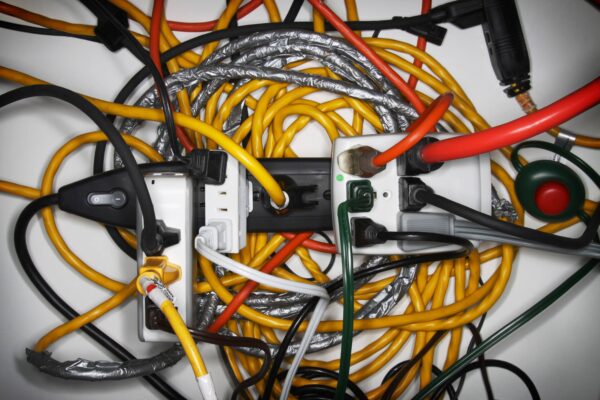Extension cords can lend to both function and aesthetics in your Raleigh, North Carolina home. If you want to plug a personal device in but lack a nearby outlet for doing so, one of these cords will solve the problem. You can use extension cords to temporarily elevate your lighting plan with task lights, a floor lamp, or a table lamp. They’re great for powering up TV and Wi-Fi accessories, home security features, and more. However, they can also be a major electrical and fire hazard if they aren’t used properly. To help you safely leverage these handy, power extenders, following are 10 things that every homeowner should know about them.
1. Extension Cords Are Not a Substitute for Fixed, Permanent Wiring
The fast-spreading signs of an aging electrical system could leave you relying on extension cords to bring power and lighting to areas that lack them. However, extension cords should never be used as long-term substitutes for fixed, functional wiring. If you have a bedroom with multiple damaged or non-working outlets, and overhead lights that won’t turn on, call an electrician. The wiring issues in this space will likely arise in other areas if necessary updates aren’t made. Moreover, even when power extenders are used correctly, there are always risks that come with leaving them plugged in for extended periods of time, and demanding too much of them.
Even if all of the outlets in your home in Apex, NC are functioning perfectly, you may not have enough of them. This is a common issue in older properties that haven’t been updated to reflect modern electricity demands. Consumers of today have far more appliances and devices to power up than did consumers of several decades ago. If your home’s electrical system hasn’t been updated in more than 20 years, scheduling this essential home improvement is far preferable to relying on extension cords.
2. Wattage Ratings for Appliances and Devices Should Be Accounted For
Before choosing and using an extension cord, make sure that it’s right for the job. There are indoor and outdoor extension cords. There are even extension cords that are rated for use in high-moisture areas. Although you never want to run an extension cord directly through water, you can find options that are safe for use outside, and on excessively humid or moderately rainy days.
When selecting extension cords for specific devices, consider the power extender’s gauge. This reflects the amount of electrical current that it can safely handle. For instance, some 16-gauge cords can handle up to 13 amps, and some 10-gauge cords can handle up to 20 amps. Cord length matters too. While 16-gauge extension cords that measure between 25 and 50 feet in length can handle up to 13 amps, a 100-foot, 16-gauge cord can only handle 10 amps. Only use cords that have been approved by independent testing laboratories. With these options, you’ll get detailed information on length, gauge, and maximum amperage that you can use to match cords to individual applications.
3. Extension Cords Should Always Be Inspected Before Use
Many homeowners keep a number of unused extension cords in storage. You might have one or more of these units hiding in your basement, attic, or closet. Before pulling it out, plugging it in, and putting it to use, give it a thorough inspection. Make sure that it hasn’t been exposed to moisture, and that it hasn’t taken any water in. Look for areas of frayed or missing insulation, bare wires, and other structural damage. Cords that are worn, excessively bent or warped, or in otherwise dubious condition should be disposed of.
4. Ground Fault Circuit Interrupters Can Prevent Electrocution
If you intend to use an extension cord in a potentially damp location, choose an outlet with ground fault circuit interrupter (GFCI) protection. This will shut the flow of power to the outlet off if the cord ever becomes submerged or takes water in in other ways. Choosing a GFCI outlet is important to do even when using an extension cord that’s rated for outdoor use.
5. Power Extenders Should Never Be Connected to Each Other
“Daisy-chaining” or connecting multiple extension cords together is always a bad idea. Electrical resistance declines with each cord that gets added to the chain. This leads to excessive voltage and electrical overload. As a result, your circuit breaker will constantly trip.
6. Extension Cords Can Create Trip and Fall Hazards
Another good reason to avoid connecting two or more extension cords together is that doing so creates a major trip and fall hazard. In fact, even a single extension cord can result in a nasty fall if it’s ill-placed or too long for its location. When using extension cords, be mindful of pets, small children, and aging adults. Overly long cords can pull heavy items off of shelves, get tangled in the wheels of wheelchairs, scooters, and walkers, and they may additionally pose the risk of strangulation.
7. Unplug Your Extension Cords When You Aren’t Using Them
Whenever extension cords are plugged in, they’re constantly conducting electricity. This remains true even if they have nothing plugged into them. Unplugging your extension cords and putting them away will keep them in good condition. It will also prevent them from taking in water during spills, overheating, or causing electrocution injuries. Keep in mind that small children and pets can sustain serious physical harm when tampering with live extension cords. To keep these individuals protected, remove power extenders from outlets, and then cover the outlets with age-appropriate safety covers.
8. Grounding Prongs Should Never Be Removed from Extension Cords
Some extension cords have three prongs instead of two. The third, circular prong on these units is known as the grounding prong. This prong is designed to supply an emergency path for electrical currents during faults and short circuits. If the outlet you’re using cannot accommodate grounding prongs, look for another option or use a different extension cord. Cutting off the grounding prong to use an extension cord in a two-prong outlet could result in a damaged device or appliance. In some instances, it may even lead to electrocution.
9. Power Extenders Should Always Be Removed by Their Plugs
Never remove a power extender by yanking the cord. These units should always be removed from outlets using their plugs instead. This will preserve the integrity of the wiring inside of the cord, and keep the cord safe for future use. To easily turn your devices and appliances off when using an extension cord, choose an appropriately rated power strip with a “power save” or “ON/OFF” button instead.
10. Extension Cords Should Never Be Covered
If you’re using an extension cord as a short-term solution to a non-working outlet, you may be tempted to run it beneath your sofa or rug. Doing so will eliminate most trip and fall hazards, but it will also create the risk of overheating and fire. If you don’t have an accessible, functional outlet in a location that requires it for lighting, appliance use, or device use, call an electrician. Covering power extenders inhibits heat loss and can result in melted components, burned or singed items, and many other problems.
In the case of outdoor use, some extension cords are sold with built-in covers. These housing units surround outlets so that rainwater, snow melt, and other moisture cannot get in. These are the only covers that should be used with extension cords, and they should always be used according to their manufacturer’s instructions.
We offer heating, cooling, plumbing, and electrical services. Our clients can count on us for whole-house surge protection, generator installation, circuit breakers, and electrical installations and repairs. If your electrical wiring system needs to be updated or if you want more outlets in your Raleigh, North Carolina home, give Thermo Direct a call today.









